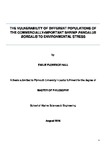THE VULNERABILITY OF DIFFERENT POPULATIONS OF THE COMMERCIALLY-IMPORTANT SHRIMP PANDALUS BOREALIS TO ENVIRONMENTAL STRESS
| dc.contributor.supervisor | Truebano, Manuela | |
| dc.contributor.author | Hall, Emilie Florence | |
| dc.contributor.other | School of Biological and Marine Sciences | en_US |
| dc.date.accessioned | 2017-05-19T13:37:33Z | |
| dc.date.issued | 2017 | |
| dc.date.issued | 2017 | |
| dc.identifier | 10134695 | en_US |
| dc.identifier.uri | http://hdl.handle.net/10026.1/9287 | |
| dc.description.abstract |
The present study adopted an integrative approach to conduct a population comparison of vulnerability to environmental stress in a commercially important species of ectotherm. Specifically, I investigated how differing environmental conditions in native habitats may drive intra-species divergence and alter performance when conditions shift. This study used northern prawn (Pandalus borealis Krøyer 1838) populations with known morphological differences from two spatially proximate fjord sites differing in oxygen regime as a model system. The genetic population structure was analysed and whole organism, physiological, and metabolomic performance under hypoxia and thermal stress were assessed. Genetic analyses displayed no significant dissimilarities between P. borealis from the normoxic and the seasonally hypoxic site. It was hypothesised that phenotypic plasticity may act as mechanism by which P. borealis may persist in the seasonally hypoxic fjord. Subsequently, a common garden experiment, in which individuals from the two fjords were exposed to hypoxia and the additional stress of elevated temperature, was carried out. The populations did not show significantly different physiological performance as determined by metabolic rates and stamina. However, the experiment did confirm the negative impacts of hypoxia on this species. Finally, P. borealis were exposed to hypoxia in the field in a translocation experiment. As the laboratory methods used would not have been possible to replicate, performance was assessed by survivorship and metabolite regulation. P. borealis from the two fjords showed significantly different levels of survivorship and the metabolomic profiles demonstrated that both populations possess different levels or forms of phenotypic plasticity, as they responded differently to translocation. This thesis presents the first use of the mtDNA control region of this species being used to determine its genetic variation and emphasises the need for multidisciplinary, holistic and multi-population approaches to assessing species vulnerability. | en_US |
| dc.description.sponsorship | Plymouth University School of Marine Science and Engineering | en_US |
| dc.description.sponsorship | Royal Swedish Academy of Sciences | en_US |
| dc.description.sponsorship | Association of European Marine Biological Laboratories | en_US |
| dc.language.iso | en | |
| dc.publisher | University of Plymouth | |
| dc.rights | CC0 1.0 Universal | * |
| dc.rights.uri | http://creativecommons.org/publicdomain/zero/1.0/ | * |
| dc.subject | Hypoxia | en_US |
| dc.subject | Phenotypic plasticity | en_US |
| dc.subject | Population comparison | en_US |
| dc.subject | Pandalus borealis | en_US |
| dc.subject | Crustacean | en_US |
| dc.subject | Physiology | en_US |
| dc.subject | Population genetics | en_US |
| dc.subject | Metabolomics | en_US |
| dc.subject.classification | MPhil | en_US |
| dc.title | THE VULNERABILITY OF DIFFERENT POPULATIONS OF THE COMMERCIALLY-IMPORTANT SHRIMP PANDALUS BOREALIS TO ENVIRONMENTAL STRESS | en_US |
| dc.type | Thesis | |
| plymouth.version | publishable | en_US |
| dc.identifier.doi | http://dx.doi.org/10.24382/560 | |
| dc.rights.embargodate | 2018-05-19T13:37:33Z | |
| dc.rights.embargoperiod | 12 months | en_US |
| dc.type.qualification | Masters | en_US |
| rioxxterms.version | NA |
Files in this item
This item appears in the following Collection(s)
-
01 Research Theses Main Collection
Research Theses Main



